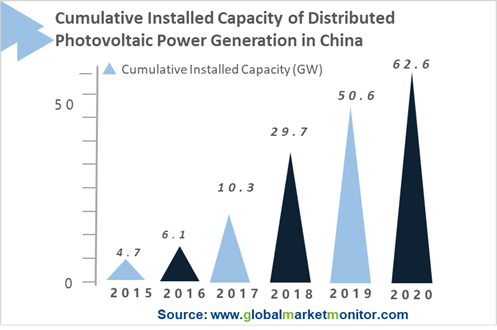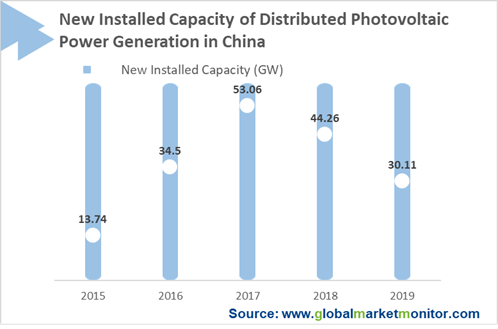Photovoltaic industry in China started in the 1970s and entered a period of steady development in the 1990s. In recent years, as the supply of traditional energy has become increasingly tight, photovoltaics, as an efficient and clean energy source, are continuously gaining national attention.
Photovoltaic is the abbreviation of the photovoltaic power generation system, which can convert solar radiation into electrical energy to supply power to users. Photovoltaics are divided into grid-connected and independent types. The grid-connected type has the characteristics of low cost and environmental protection, which is becoming the mainstream of the photovoltaic industry and divided into ground power stations and distributed photovoltaics. The domestic solar market is dominated by ground power stations. However, considering that ground power stations require a large amount of land, it is not suitable for the eastern and central regions which are economically developed and densely populated. Therefore, more attention to distributed photovoltaics has been increasing.
Enquire before purchasing this report-
https://www.globalmarketmonitor.com/request.php?type=3&rid=406047
The Highlight Stage of Distributed Photovoltaics
In July 2013, the State Council document clearly stated that it was necessary to vigorously develop the distributed photovoltaic market. In 2014, the National Energy Administration set a target of 14GW for annual photovoltaic installations that year, of which distributed photovoltaics alone was 8GW, accounting for almost 60% of the total installed capacity. However, due to the unclear business model and the immature photovoltaic environment, the development of distributed photovoltaics at that time just maintained a slow growth.
From 2014 to 2017, different from the policy of lowering the electricity price subsidy for the three types of resource areas, the National Development and Reform Commission reduced the subsidy for distributed photovoltaic kilowatt-hours for the first time in 2017, from the initial 0.42 yuan per kilowatt-hour to 0.37 yuan per kilowatt-hour, which was just a small reduction compared with the previous adjustment of other photovoltaic subsidies.
In 2017, distributed photovoltaics, especially the household photovoltaic market, ushered in a major explosion due to many reasons such as the impact of abandonment of ground photovoltaic power stations and the increase in distributed revenue. According to relevant statistics, the scale of the household photovoltaics increased from about 20,000 sets in 2015 to 149,800 sets in 2016, about 7.3 times, which continued to rise in 2017, reaching 530,000 sets. Therefore, before 2017, the installed capacity of distributed photovoltaics was soaring, whose cumulative volume reached 29.66GW, a year-on-year increase of 187.0%.

The Darkest Moment of Distributed Photovoltaic
This grand event stopped abruptly after the "531". On May 31, 2018, as the development momentum of distributed photovoltaics exceeded expectations, its higher subsidy intensity further exacerbated the existing subsidy gap. Thus, the National Energy Administration issued a series of policies at the meeting that day to step on the brakes for the distributed photovoltaics industry, known as the "531 New Deal", in which the distributed photovoltaic kilowatt-hour subsidy standard was adjusted to 0.32 yuan per kilowatt-hour. In 2019, the subsidy standards for industrial and commercial distributed photovoltaics and household distributed photovoltaics were adjusted to 0.10 yuan per kilowatt-hour and 0.18 yuan per kilowatt-hour respectively. All photovoltaic fields, including distributed photovoltaics, has been moving forward in difficulties.
According to data, the output of polysilicon in the first half of 2018 increased by about 24% year-on-year, while the annual output increased by only 3.3%, and the output of silicon wafers increased by about 39% in the first half of the year, while the year-on-year increase was 19.1%. In 2019, the number of photovoltaic installations nationwide still declined. The domestic new installed photovoltaic power generation capacity was 30.11GW, a year-on-year decrease of 31.6%, of which the new installed capacity of centralized photovoltaic was 17.91GW, a year-on-year decrease of 22.9% and that of distributed photovoltaic power generation was 12.20GW, a year-on-year decrease of 41.8%.

Distributed photovoltaic power generation is a new type of power generation and comprehensive energy utilization method with broad development prospects, which can not only improve the power generation efficiency of photovoltaic power stations of the same scale but also effectively solve the problem of power loss during boosting and long-distance transportation.
How Does Distributed Photovoltaic Merge with Financial Leasing?
Due to the large amount of capital demand and the long cycle of capital demand, the photovoltaic industry is facing difficulties in financing, especially for distributed photovoltaic power generation. Although photovoltaic companies have many financing methods, financing through policy banks or commercial bank loans is still difficult, which is also a factor that promotes the integration of the photovoltaic industry and financial leasing.
From the perspective of financial leasing companies, in the context of numerous uncertainties in the global economic environment and the financial industry generally facing "asset shortage", photovoltaic power plants have become a high-quality asset due to their long-term stable cash flow, whose features of the large investment and the long payback period of funds coincides with the financial leasing method.
Lease is the core equipment of the photovoltaic power station. The overall liquidity still exists with the equity of the photovoltaic power station. Moreover, photovoltaic power plants are different from ordinary production-oriented the enterprise, which are the main business entity formed with the power station. Photovoltaic power plants have very stable cash flow, in which the main problem at present is the national subsidy. Up to now, the state has a subsidy gap of nearly 200 billion yuan for photovoltaic power plants, which will be filled through the renewable energy fund and fossil energy consumption companies to purchase this indicator as the state is actively launching green certificates.
LEARN MORE:
Solar Photovoltaic
https://www.globalmarketmonitor.com/reports/406047-solar-photovoltaic-market-report.html
Custom Reporting
https://www.globalmarketmonitor.com/request.php?type=9&rid=0
We provide more professional and intelligent market reports to complement your business decisions.